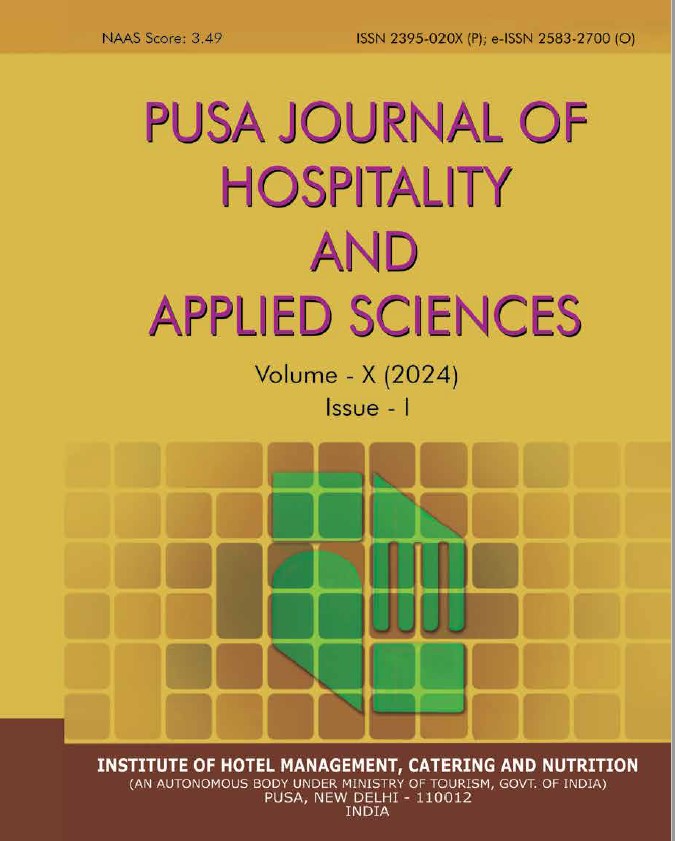Survey Analysis Of Common Foot Problems Among Hotel Employees In Delhi-Ncr
Keywords:
Foot Problems, Hotel Employees, Hospitality Industry, Health IssuesAbstract
Background: Importance of proper foot care in general should be a concern for people as foot problems causes hindrances in their day to day activities. The problem actually becomes a major concern when it does not allow a person to function at their workplace. For decades people have had to suffer from many foot problems that occur due to the fact that they have to either be in constant standing position or in constant motion at their workplace. Objectives: The study identified the different types of foot and health problems seen in hotel employees and its relation with footwear. Methodology: This study falls within a quantitative research approach. To determine the foot problems in hotel employees, data collection was done at four different hotels. The variables responsible for causing foot problems were listed in a questionnaire and were analyzed in relation to the workplace using a cause and effect correlational quantitative design. The sample size taken was 32. Sampling technique used was a random probability sampling method. Of the total participants 62.5% were male and the rest 37.5% were female. The participants were in the age bracket of 19-48 years. The locale for data collection was Five Star Hotels in Delhi NCR region. The results were analyzed on the basis of footwear and department employee worked in. Results: In this study it was found that 87.5% of the participants had to stand for more than 6 hours at their workplace. Blisters with 41.4% and Corn with 34.5% were found to be the most common foot problem faced by Hotel Employees. Swelling, Back Pain and Muscle Fatigue were the most common Health Related issues found among Hotel Employees with existing Foot Problems. Conclusion: Every organization needs to assess the footwear used by their employees and make them wear footwear which is comfortable, better fitting, have soft mattress. Also the organization needs to ensure that while working an employee practices good amount of ergonomic principles, incorporate breaks during his shift and follow better gait practices.
References
APMA. (2014). Public Opinion Research on Foot Health and Care. https://www.apma.org/ files/APMA2014TodaysPodiatristSurveyAllFindings.pdfm
Dansinger, M. (2021, June 22). Diabetic Foot Problems. https://www.webmd.com/diabetes/ foot-problems
Emmanouill, A.A., & Rousanoglou, E.N. (2018). Effect of High Heeled Shoe on Postural Control in the Upright and the Leaning Body Stance. Phys Med Rehabil Res 2018, Volume 3(5), 1-5.
Fields, K.B., (2015). Evaluation and Diagnosis of Common Causes of Foot Pain in Adults. http://www.uptodate.com/home.
Garcia, M.G., Laubli, T., & Martin, B.J. (2015). Prolonged Standing Associated with Musculoskeletal Disorders. Human Factors, Vol. 57(7), 1162-73.
Halim, I., & Omar, A.R. (2011). A review on Health Effects Associated with Prolonged viii Standing in The Industrial Workplaces. IJJRAS, 8(1).
Hansen, L., Winkel, J., & Jorgensen, K. (1998). Significance of Mat and Shoe Softness during prolonged work in upright position. Applied Ergonomics, Vol. 29(3), 217-224.
Harrison, B.M., Hashmi, F., Nester, C., & Williams, A.E. (2017). The Prevalence of Foot Problems in an Indian Population. The Diabetic Foot Journal, Vol. 20(2), 95-102.
Indian Podiatry Association. https://www.indiamart.com/indian-podiatry-association-new/
Manna, I., Pradhan, D., Ghosh, S., Kar, S.K., & Dhara, P. (2001). A Comparative Study of Foot Dimension Between Adult Male and Female and Evaluation of Foot Hazards due to using Footwear. J PhysiolAnthropol, Volume 20(4), 241-246.
Marr, S.J., & Quine, S. (1991). Shoe Concerns and Foot Problems of wearers of Safety Footwear. Occupational Med. 1993, Volume 43, No 2, 73-77.
Mayoclinic. (2021, March 13). Foot pain. https://www.mayoclinic.org/symptoms/foot-pain/ basics/causes/sym-20050792.
McRitchie, M., Branthwaite, H., & Chockalingam, N. (2018). Footwear choices for Painful feet – An Observational study exploring Footwear and Foot Problems in Women. Journal of Foot and Ankle Research 2018.
Messing, K., & Kilbom, A. (2000). Standing and very slow walking: Foot Pain Pressure Threshold, Subjective Pain Experience and Work Activity. Applied Ergonomics, Volume 32(2001), 81-90.
Orlando, A.R., & King, P.M. (2004). Relationship of Demographic Variables on Perception of Fatigue and Discomfort following prolonged standing under various flooring conditions. Journal of Occupational Rehabilitation, Volume 14(1).
Seid, A., & Tsige, Y. (2015). Knowledge, Practice, and Barriers of Foot Care among Diabetic Patients attending FelegeHiwot Referral Hospital, Bahir Dar, Northwest Ethiopia. Advances in Nursing 2015.
Waters, T. R., & Dick, R.B. (2015). Evidence of Health Risks Associated with Prolonged Standing Work and Intervention Effectiveness. RehabilNurs. 2015, Volume 40(3), 148- 165.
Wiggermann, N., & Keyserling, W.M. (2013). Effects of Anti Fatigue Mats on Perceived Discomfort and Weight Shifting during Prolonged Standing. Human Factors, Volume 55(4), 764 -775.
Woolever, L. (2012). High-End Food, Low-Wage Labor. Dissent Magazine.




